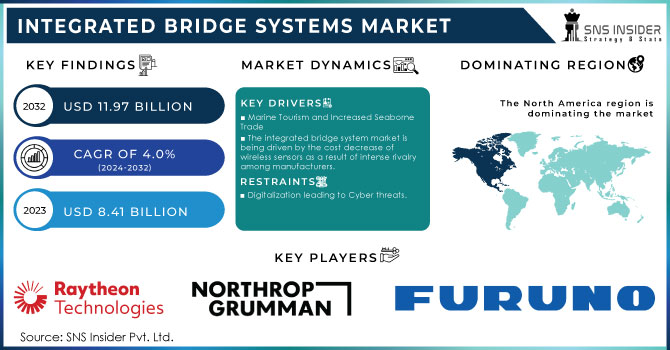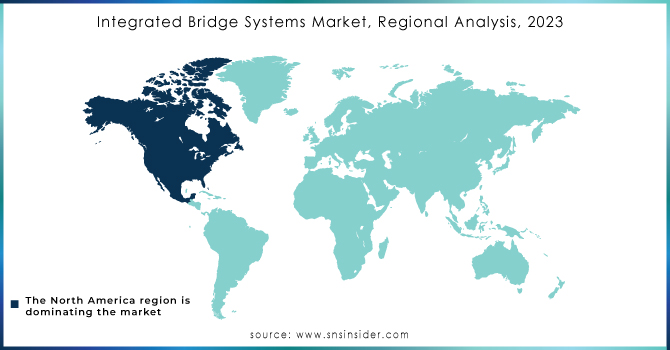Integrated Bridge Systems Market Report Scope & Overview:
The Integrated Bridge Systems Market Size was valued at USD 8.41 billion in 2023, expected to reach USD 11.97 billion by 2032 with a growing CAGR of 4.0% over the forecast period 2024-2032.
The integrated bridge systems market is expanding rapidly due to increased demand for advanced maritime navigation systems. The integrated bridge system is a collection of systems designed to provide centralized access to information from diverse system nodes via a workstation. Furthermore, IBS sends information like navigation, control and monitoring, and propulsion on interconnected grouped screens to enable safe and effective ship management. Furthermore, an integrated bridge system receives data from a variety of on-board sensors, subsystems, and a ship's navigational system. IBS enables real-time data monitoring to improve situational awareness and decision-making efficiency. Marine vessels use an integrated bridge system. It serves as an intermediate ship management system. It is used to increase the safety and efficiency of maritime vessels as all vessels are connected to the system where the officer can monitor all the activities of the vessel.
An integrated bridge system is a computer program that monitors all ship conditions in a single system. Controls all ship navigation sensors and control system information. IBS brings the right combination of each roaming function, the same operating principles, and an easy-to-use user interface. In addition to this, it also collects information from various ship sensors and shipping systems. In accordance with Integrated Bridge Systems Market Analysis, the system enhances the overall performance of the driver. It makes it easier for the industry not to worry too much about security. The market size of the integrated bridge system will improve over the forecast period. The use of an integrated bridge system for bridges could reduce shipping risks, and previously many vessels were lost. But, with this system, the status of the vessel will be in a specific control system for each vessel.

To get more information on Integrated Bridge Systems Market - Request Free Sample Report
MARKET DYNAMICS
KEY DRIVERS
-
Marine Tourism and Increased Seaborne Trade
-
The integrated bridge system market is being driven by the cost decrease of wireless sensors as a result of intense rivalry among manufacturers.
RESTRAINTS
-
Digitalization leading to Cyber threats.
OPPORTUNITIES
-
increasing number of port cities in Asian countries
-
Precise navigational safety standards & regulations
CHALLENGES
-
Extravagant customization of IBS
-
The availability of experienced staff is a significant issue for the market expansion of integrated bridge systems.
IMPACT OF COVID-19
Because of the government-imposed lockdown to halt the spread of COVID-19, integrated bridge system manufacturers are experiencing operational challenges and a labour shortage.
Ship builders are compelled to halt production owing to a government-imposed lockdown in the aftermath of COVID-19.
International travel limitations implemented by authorities to combat the COVID-19 epidemic have harmed the maritime trade and tourism industry.
Manufacturers of integrated bridge systems are unable to obtain production-related equipment and raw materials due to supply chain disruption induced by government traffic restrictions imposed in the aftermath of the COVID-19 outbreak.
Based on the component segment, the Integrated Bridge Systems Market is split into hardware and software. The hardware segment is subdivided further into control units, displays, data storage, sensors, alarms, and so on. The increased need for novel systems for commercial and defense vessels boosts the market growth. In the projection period, the software segment will grow due to the growing demand for software applications for various ships and shipbuilders.
The integrated bridge system market is divided into OEM and aftermarket segments depending on the end-user. The growing demand for navy ships with modern integrated bridge systems drives the expansion of the OEM segment, which is predicted to grow at a rapid pace throughout the forecast period. As navy vessels are modified for passenger safety, the aftermarket area will see significant development. based on ship type The integrated bridge systems market has been divided into defense and commercial segments.
Over the forecast period, the commercial segment is expected to lead the market. An increase in the number of people using marine transportation and an increase in demand for leisure boats are expected to drive the commercial segment of the integrated bridge systems market worldwide.
KEY MARKET SEGMENTATION
By Component
-
Software
-
Hardware
By End User
-
OEM
-
Aftermarket
By Ship Type
-
Commercial
-
Defense
By Sub System
-
Voyage Data Recorder
-
Integrated Navigation System
-
Automatic Weather Observation System
-
Others
By Tonnage
-
<10 t
-
<100t
-
<1000t
-
>1000t
REGIONAL ANALYSIS
The integrated bridge system market has been distributed for market expansion across North America, Asia Pacific, and Europe. North America will improve the market's CAGR due to the region's various bridge system developers; in the United States, the defence budget also boosts the region's market growth. Another element influencing North America's growth rate is a rise in import-export activity in the region. Increased port capacity in Asian regions will boost Asia Pacific growth during the projection period. According to the market analysis for integrated bridge systems, each region will contribute to market growth.

Need any customization research on Integrated Bridge Systems Market - Enquiry Now
REGIONAL COVERAGE:
-
North America
-
USA
-
Canada
-
Mexico
-
-
Europe
-
Germany
-
UK
-
France
-
Italy
-
Spain
-
The Netherlands
-
Rest of Europe
-
-
Asia-Pacific
-
Japan
-
south Korea
-
China
-
India
-
Australia
-
Rest of Asia-Pacific
-
-
The Middle East & Africa
-
Israel
-
UAE
-
South Africa
-
Rest of Middle East & Africa
-
-
Latin America
-
Brazil
-
Argentina
-
Rest of Latin America
-
KEY PLAYERS
The Major Players are Northrop Grumman Corporation, Raytheon Company, Furuno Electric Co. Ltd., Japan Radio Co. Ltd., Kongsberg, Wärtsilä, Rolls Royce Holdings plc, LARSEN & TOUBRO LIMITED, NORIS Group Gmb, Furuno Finland and Other Players
| Report Attributes | Details |
|---|---|
| Market Size in 2023 | USD 8.41 Billion |
| Market Size by 2032 | USD 11.97 Billion |
| CAGR | CAGR of 4% From 2024 to 2032 |
| Base Year | 2022 |
| Forecast Period | 2024-2032 |
| Historical Data | 2020-2022 |
| Report Scope & Coverage | Market Size, Segments Analysis, Competitive Landscape, Regional Analysis, DROC & SWOT Analysis, Forecast Outlook |
| Key Segments | • By Component (Software and Hardware) • By End User (OEM and Aftermarket) • By Ship Type (Commercial and Defense) • By Sub System (Automatic Identification System, Voyage Data Recorder, Integrated Navigation System, Automatic Weather Observation System and Others) |
| Regional Analysis/Coverage | North America (USA, Canada, Mexico), Europe (Germany, UK, France, Italy, Spain, Netherlands, Rest of Europe), Asia-Pacific (Japan, South Korea, China, India, Australia, Rest of Asia-Pacific), The Middle East & Africa (Israel, UAE, South Africa, Rest of Middle East & Africa), Latin America (Brazil, Argentina, Rest of Latin America) |
| Company Profiles | Northrop Grumman Corporation, Raytheon Company, Furuno Electric Co. Ltd., and Japan Radio Co. Ltd., Kongsberg, Wärtsilä, Rolls Royce Holdings plc, LARSEN & TOUBRO LIMITED, NORIS Group Gmb, Furuno Finland. |
| DRIVERS | • Marine Tourism and Increased Seaborne Trade • The integrated bridge system market is being driven by the cost decrease of wireless sensors as a result of intense rivalry among manufacturers. |
| RESTRAINTS | • Digitalization leading to Cyber threats. |

